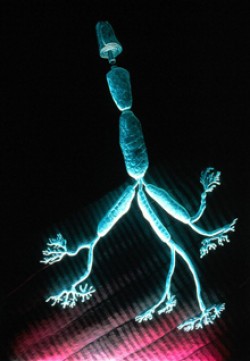New Genetic Mutations Discovered in Families with ALS
New Genetic Mutations Discovered in Families with ALS
Scientists have linked newly discovered genetic mutations to some cases of the fatal disorder amyotrophic lateral sclerosis (ALS), also known as Lou Gehrig’s disease. The finding sheds light on how ALS can harm the structure and growth of nerve cells, leading to rapidly progressive paralysis.

The long axon of a motor neuron relays signals from nerve to muscle cells. Mutations in the PFN1 gene may inhibit axon growth. Image by John Wildgoose, Wellcome Images. All rights reserved by Wellcome Images.
ALS is a neurodegenerative disease that attacks motor neurons—the nerve cells responsible for controlling muscle movement. It often strikes people between 40 and 60 years of age. Early symptoms include limb weakness and difficulty swallowing. Death from respiratory failure often occurs within 3 to 5 years after symptoms first appear.
Although about 9 in 10 cases of ALS are sporadic—meaning the cause is unknown—a small percentage of patients have a family history of the disease. Analysis of these families over the years has linked more than a dozen genes to inherited forms of ALS. Still, in nearly half of familial cases, potential genetic causes remain unknown. Because scientists believe that both sporadic and familial forms of ALS likely occur through similar mechanisms, studying these genetic mutations could provide clues to how the majority of ALS cases develop.
Scientists led by Dr. John Landers of the University of Massachusetts Medical School collaborated with international ALS researchers to search for genetic mutations in 2 large families with an inherited form of ALS. The study was funded in part by NIH’s National Institute of Neurological Disorders and Stroke (NINDS).
On July 15, 2012, in the online edition of Nature, the team reported that they had found several mutations in the gene profilin-1 (PFN1), which had not previously been linked to ALS. The mutations were present only in family members who developed the disease. Further investigations of an additional 274 familial ALS cases around the world showed that profilin-1 mutations occurred in a small subset (up to 2%) of the cases studied.
The profilin-1 protein is involved in the creation and remodeling of a nerve cell’s scaffolding or cytoskeleton. Earlier studies in flies found that defects in profilin-1 can stunt the growth of axons—the long cell projections that relay signals from one neuron to the next or to muscle cells. After identifying the PFN1 mutations in ALS patients, the researchers showed that these mutations also inhibited axon growth in laboratory-grown motor neurons.
The scientists also found that mutant profilin-1 accumulated in clumps within neural cells. Clumping of abnormal proteins is a hallmark of several neurodegenerative diseases, including ALS, Parkinson’s disease and Alzheimer’s disease. Some clumps of abnormal profilin-1 also contained a protein called TDP-43. TDP-43 clumps are found in most cases of ALS, further linking profilin-1 to known ALS mechanisms.
Although the PFN1 mutations are linked to familial ALS, the new finding offers insights into the mechanisms underlying motor neuron degeneration in general, the scientists say. The results may also have broader implications for understanding sporadic ALS.
“In all of the causative genes that we identify, we look for common pathways,” says Landers. “Every time we are able to identify a new gene, we have another piece of the puzzle.”
###
* The above story is reprinted from materials provided by National Institutes of Health (NIH)
** The National Institutes of Health (NIH) , a part of the U.S. Department of Health and Human Services, is the nation’s medical research agency—making important discoveries that improve health and save lives. The National Institutes of Health is made up of 27 different components called Institutes and Centers. Each has its own specific research agenda. All but three of these components receive their funding directly from Congress, and administrate their own budgets.




















